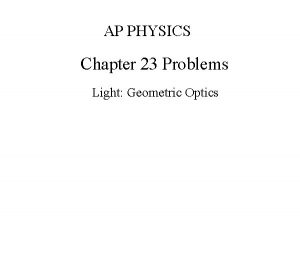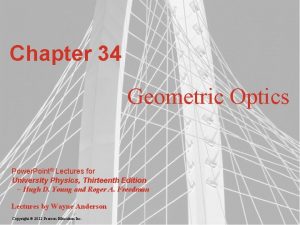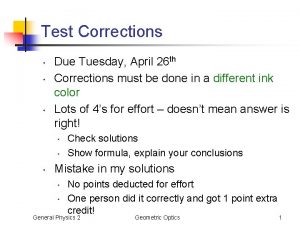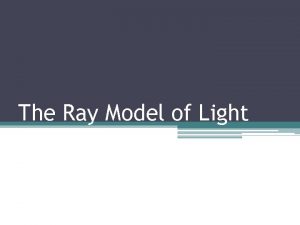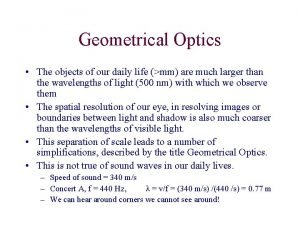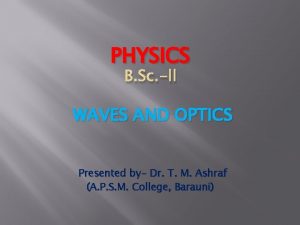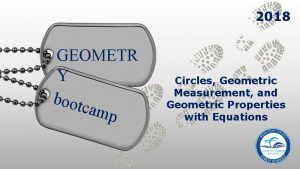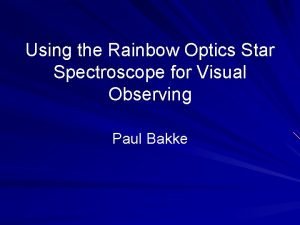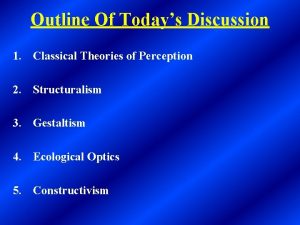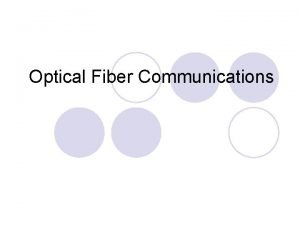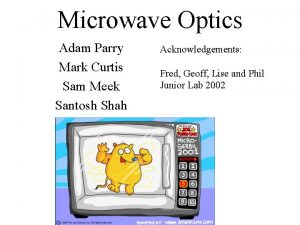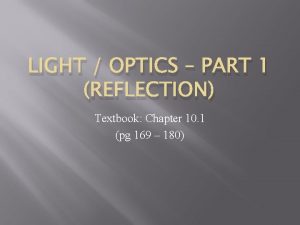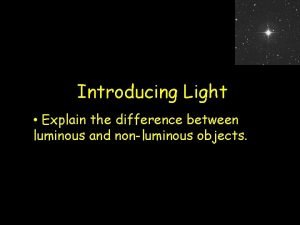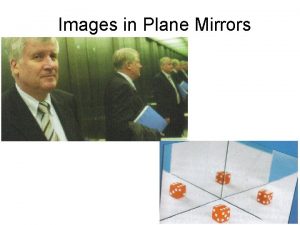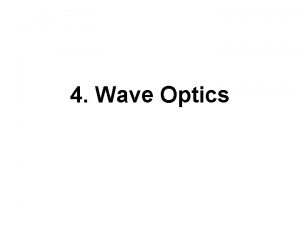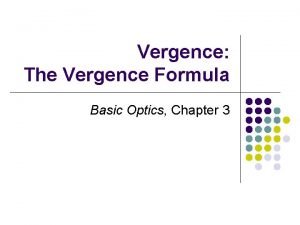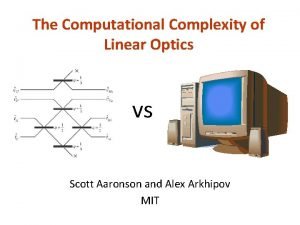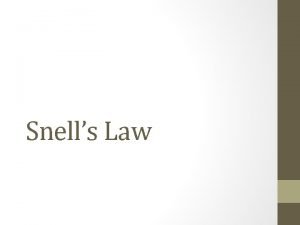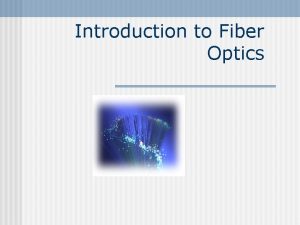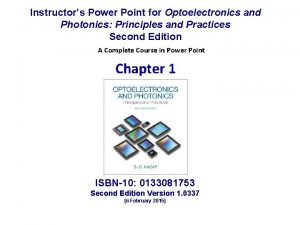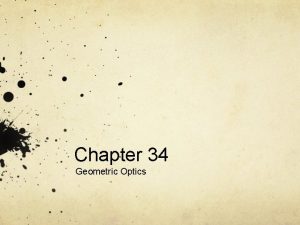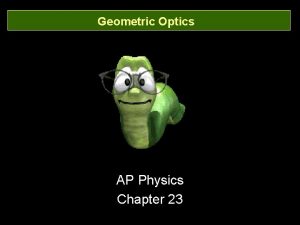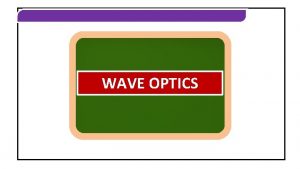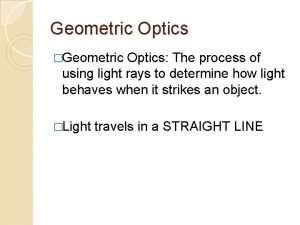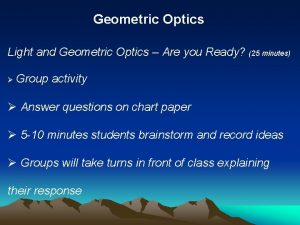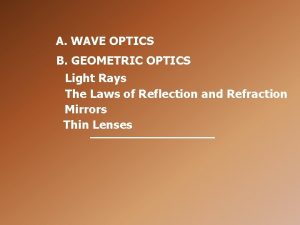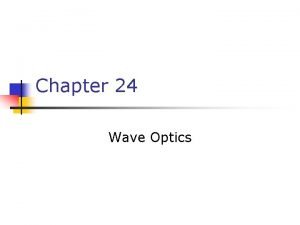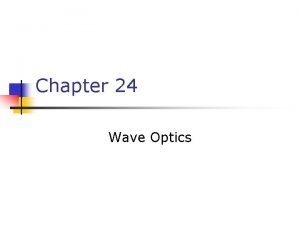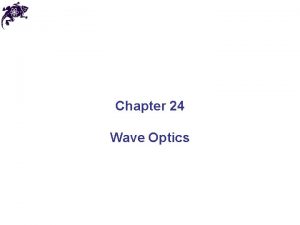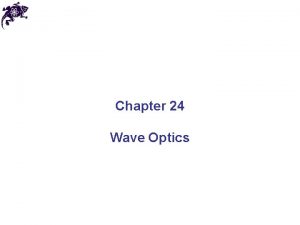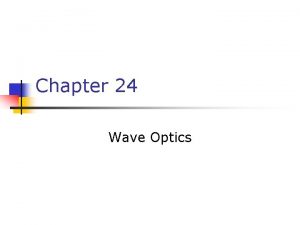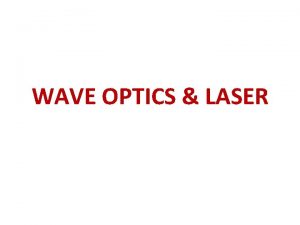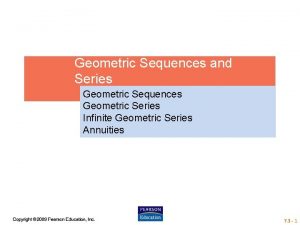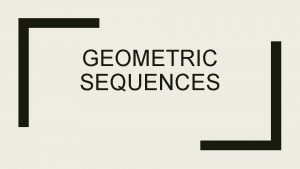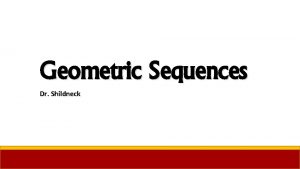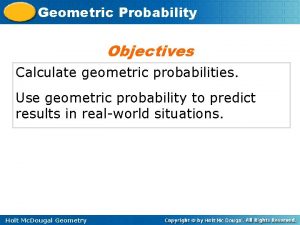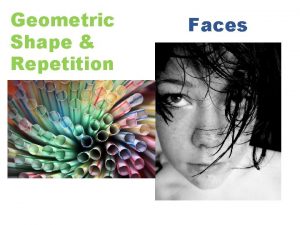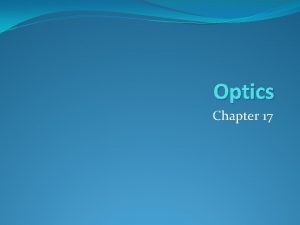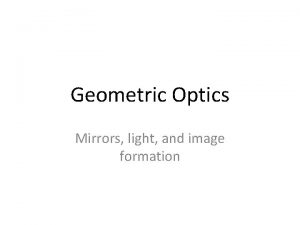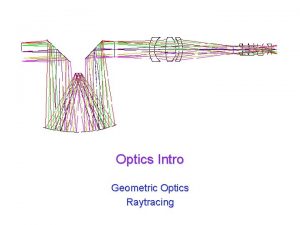Chapter 25 Wave Optics Wave vs Geometric Optics











































- Slides: 43

Chapter 25 Wave Optics

Wave vs. Geometric Optics Light is a wave (sometimes) Has wavelength And frequency Travels with speed c Geometric Optics – good when length scales are much larger than light wavelength Wave Optics – good when length scales are on the same order as light wavelength

Interference Waves interference in phase – their maxima occur at the same time at a given point in space out of phase – their maxima do not occur at the same time at a given point in space Resultant Wave = add the amplitudes of the two waves Section 25. 1

Interference Special cases of phase differences constructive interference = perfectly in phase = 0° phase difference destructive interference = completely out of phase = 180° phase difference = π phase difference = λ/2 difference Amplitude of wave (E or B) fields is what you are adding Section 25. 1

Conditions for Interference The waves must have the same frequency The waves must also have a fixed phase relationship Means that phase difference between the waves remains constant (in time or space) These waves are called coherent We will only discuss coherent waves Section 25. 1

Coherence, cont. With slightly different frequencies, the interference changes from constructive to destructive and back NOT COHERENT Section 25. 1

Coherence Example Start with beam and split it into two coherent beams One beam travels straight Other beam takes a less travelled path (#yolo) Recombine them and discuss conditions of Constructive interference Destructive interference

Intensity Example I = utotal x c = ½ εo c Eo 2 Electric Fields add Linearly Intensity does not add Linearly

Thin-Film Interference Why all these pretty colors? Section 25. 3

Thin-Film Interference Assume a thin soap film rests on a flat glass surface incoming beam (1) split into two coherent beams reflects part of the incoming light (2) allows the rest to be transmitted through (refraction) (3) reflects again at glass interface and exists soap film (refraction) (3) Section 25. 3

Thin-Film Interference The two outgoing rays recombine (2) and (3) upon exiting film Whether or not they are in phase / out of phase depends on: Extra distance travelled by (3) Phase changes at interfaces (air/soap, soap/glass)

Thin-Film Interference Index of refraction of the film – speed of light in film Speed of light inside the film Wavelength changes inside film The frequency does not change Section 25. 3

Thin-Film Interference Extra distance travelled by (3) = 2 d Ignoring phase changes at interfaces Constructive condition: Section 25. 3

Thin-Film Interference Extra distance travelled by (3) = 2 d Ignoring phase changes at interfaces Destructive condition: Section 25. 3

Phase Change at Interfaces When light wave reflects from surface it may feel like changing phase Why? cuz… #yolo

Phase Change at Interfaces There is a phase change whenever the reflection is from a larger n (than medium you are in) No phase change if reflection is from a smaller n (than medium you are in) The phase change is 180 degrees a. k. a. π radians a. k. a. λ/2 difference

Thin-Film Interference Now we don’t ignore phase changes at interfaces Beam (2) undergoes phase change of λ/2 at AS interface Beam (3) undergoes phase change of λ/2 at SG interface Lets determine condition of constructive interference: Section 25. 3

Thin-Film Interference Lets determine condition of con(des)structive interference for B: Constructive Destructive

Thin-Film Interference Lets determine condition of con(des)structive interference for C: Constructive Destructive

Thin-Film Example Oil (n=1. 51) is spread over puddle of water (n=1. 33). In a region where the film looks blue (λ=450 nm) what is the minimum thickness of the film?

Light Through (n)-Slits Light passes through a slit – single slit (SS) or two – double slit (DS) or many – diffraction grating (DG) If width of the slit ~ wavelength of the light things get weird Section 25. 4

Single-Slit Interference Diffraction is the bending or spreading of a wave when it passes through a narrow opening Like water, light is a wave This will happen to light Section 25. 4

Huygens’ Principle Huygen’s Principle can be stated as all points on a wave front can be thought of as new sources of spherical waves Section 25. 4

Double-Slit Interference Light passes through two very narrow slits Each slit acts as a point source of new waves The double slit experiment showed that light acts like a wave Thomas Young – 1800 Rays from each slit travel different paths When they meet, the phase diff. will determine how they interfere Section 25. 5

Double Slit Analysis Assume W is very large Slits are separated by a distance d Difference in length between the paths of the two rays is Section 25. 5

Double-Slit Intensity Pattern The angle θ varies as you move along the screen Each bright fringe corresponds to a different value of m Negative values of m mean θ goes CW Bright fringe = high light intensity = constructive interference Dark fringe = zero light intensity = destructive interference Section 25. 5

Double-Slit Intensity Pattern Bright fringe = high light intensity = constructive interference Dark fringe = zero light intensity = destructive interference Section 25. 5

Double-Slit Intensity Pattern Notation: d is the distance between the slits W is the distance between the slits and the screen h is actual physical distance on the detector θ is the angle with respect to center Section 25. 5

Double-Slit Example Assume a DS setup with d=0. 016 cm, W=2. 4 m. The distance between the bright fringes is 0. 77 cm. What is the wavelength of the light used? Section 25. 5

Single-Slit Analysis Similar to DS Use Huygen’s principle Points across the slit act as wave sources These different waves interfere at the screen Condition for destructive interference is: no simple formula for bright fringes occur Section 25. 6

Single-Slit Analysis Dark fringe = zero light intensity = destructive interference Section 25. 6

Diffraction Grating Many slits is called a diffraction grating Assumptions The slits are narrow Each one produces a single outgoing wave The screen is very far away Condition for constructive interference is: Section 25. 7

Diffraction Grating Bright fringe = high light intensity = constructive interference Section 25. 7

Diffraction Grating The condition for bright fringes from a diffraction grating is identical to the condition for constructive interference from a double slit Intensity pattern depends on the number of slits Larger the number of slits, the narrower the peaks Section 25. 7

Diffraction and CDs Light reflected from the arcs in a CD acts as sources of Huygens waves The reflected waves exhibit constructive interference at certain angles Light reflected from a CD has the colors “separated” Section 25. 7

DG Example A DG had 8000 lines uniformly spaced over 3 cm. It is illuminated by mercury lamp which produces wavelength of 546 nm. What is the angle at which the third-order maximum appears?

Optical Resolution For a circular opening of diameter D, the angle between the central bright maximum and the first minimum is The circular geometry leads to the additional numerical factor of 1. 22 Section 25. 8

Telescope Example Look at a star through a telescope Diffraction at the opening produces a circular diffraction spot Oh wait… there actually two stars The two waves are incoherent -> do not interfere Each source produces its own different pattern Section 25. 8

Rayleigh Criterion If the two sources are sufficiently far apart, they can be seen as two separate diffraction spots (A) If the sources are too close together, their diffraction spots will overlap so much that they appear as a single spot (C) Section 25. 8

Rayleigh Criterion, cont. You can tell there are two sources if their angular separation is greater than the angular spread of a single diffraction spot This is called the Rayleigh criterion For a circular opening, the Rayleigh criterion for the angular resolution is Two objects will be resolved when viewed through an opening of diameter D if the light rays from the two objects are separated by an angle at least as large as θmin Section 25. 8

Rayleigh Scattering When the wavelength is larger than the reflecting object, the reflected waves travel away in all direction and are called scattered waves The light that scatters most is one with wavelength about same size as object Blue light is scattered more than red Called Rayleigh scattering Section 25. 9

Why is the sky blu? Light from sun is scattered by molecules in atmosphere The molecules are much smaller than the wavelength of visible light They scatter blue light more than red (smaller wavelength) This gives the atmosphere its blue color Wow. Section 25. 9

Nature of Light Interference and diffraction show convincingly that light has wave properties Have strong evidence that light is both a particle and a wave Called wave-particle duality Quantum theory tries to reconcile these ideas Section 25. 10
 Venn diagram of geometric optics and physical optics
Venn diagram of geometric optics and physical optics Difference between ray optics and wave optics
Difference between ray optics and wave optics Optics
Optics Geometrical optics ppt
Geometrical optics ppt Physics 2
Physics 2 Light ray model
Light ray model Total internal reflection in daily life
Total internal reflection in daily life Http //vsg.quasihome.com
Http //vsg.quasihome.com Wave optics b.sc physics
Wave optics b.sc physics 2018 geometry bootcamp answers
2018 geometry bootcamp answers Electromagnetic waves are longitudinal waves true or false
Electromagnetic waves are longitudinal waves true or false What is a semiconductor used for
What is a semiconductor used for Difference between full wave and half wave rectifier
Difference between full wave and half wave rectifier Transverse and longitudinal waves both *
Transverse and longitudinal waves both * Examples of half wave rectifier
Examples of half wave rectifier Full wave rectifier ic
Full wave rectifier ic P and s wave arrival time chart
P and s wave arrival time chart Full wave rectified sine wave fourier series
Full wave rectified sine wave fourier series Wave wave repeating
Wave wave repeating The wave chapter 10
The wave chapter 10 Half wave symmetry examples
Half wave symmetry examples Electromagnetic and mechanical waves
Electromagnetic and mechanical waves Example of mechanical waves
Example of mechanical waves Velocity frequency wavelength triangle
Velocity frequency wavelength triangle Rainbow optics star spectroscope
Rainbow optics star spectroscope Gestaltism
Gestaltism Turba optics
Turba optics Losses in optical fiber
Losses in optical fiber Curtis parry
Curtis parry Single ray
Single ray Grade 10 optics review
Grade 10 optics review Purdue phys 241
Purdue phys 241 Luminous and non luminous objects difference
Luminous and non luminous objects difference Properties of plane mirror image
Properties of plane mirror image Hotwire fiber optics
Hotwire fiber optics Single slit envelope
Single slit envelope With the rule astigmatism
With the rule astigmatism Fourier optics
Fourier optics Vergence formula
Vergence formula The computational complexity of linear optics
The computational complexity of linear optics Snell’s law
Snell’s law Bill nye light and optics
Bill nye light and optics Introduction to fiber optics
Introduction to fiber optics Cauchy formula optics
Cauchy formula optics


